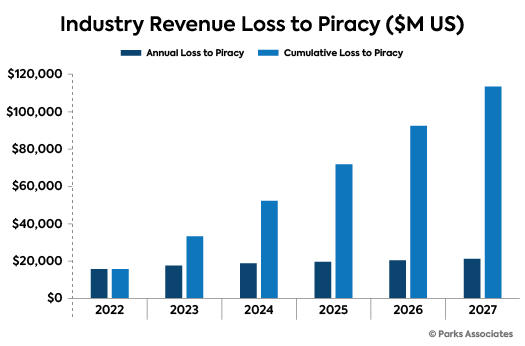
After more than 40 years of operation, DTVE is closing its doors and our website will no longer be updated daily. Thank you for all of your support.
Streaming services faces $113 billion loss to piracy by 2027
 International research firm Parks Associates forecasts streaming services in the US could face a loss of $113 billion to piracy by the end of 2027.
International research firm Parks Associates forecasts streaming services in the US could face a loss of $113 billion to piracy by the end of 2027.
The firm’s latest report found piracy rates for US streaming services are expected to rise from 22% in 2022 to 24.5% in 2027. This also sees the value of fraudulent advertising delivered online to media and entertainment consumers reaching over $700 million in 2027.
The new study Streaming Piracy Market & Ecosystem Strategies noted that visits to pirate hosting websites increased by 31% in 2020.
“While there is some optimism that emerging countermeasures and best-practices may see piracy begin to plateau by 2027, there is no consensus among stakeholders as to when it may begin to decline,” said Steve Hawley, contributing analyst, Parks Associates, and managing director of the Piracy Monitor industry newsletter and consultancy. “This research provides a much-needed understanding of the issues at hand and the technologies and approaches available to fight piracy.”
The company said this research indicates that video service providers may reduce the motivation for password sharing by restricting the number of users who can stream the service simultaneously. However, this will have a negative impact on the user experience for online video users and act as a deterrent to password sharing.
As of result, Netflix is introducing a feature that will allow users to share accounts for an extra fee, and Adobe launched “Prime Account IQ” to help providers identify when viewers are sharing credentials.
“The number of households who share account credentials and consume pirated content is rising. People are increasingly looking for new ways to satisfy entertainment needs,” said Sarah Lee, research analyst, Parks Associates, and contributor to the report. “Participation in sharing account credentials increased 48% since 2019.”


